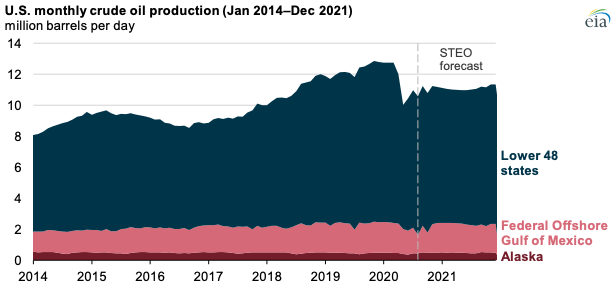In the U.S. Energy Information Administration’s (EIA) November Short-Term Energy Outlook (STEO), EIA forecasts that U.S. crude oil production will remain near its current level through the end of 2021.

A record 12.9 million barrels per day (b/d) of crude oil was produced in the United States in November 2019 and was at 12.7 million b/d in March 2020, when the President declared a national emergency concerning the COVID-19 outbreak. Crude oil production then fell to 10.0 million b/d in May 2020, the lowest level since January 2018.
The U.S. crude oil production forecast reflects EIA’s expectations that annual global petroleum demand will not recover to pre-pandemic levels (101.5 million b/d in 2019) through at least 2021. EIA forecasts that global consumption of petroleum will average 92.9 million b/d in 2020 and 98.8 million b/d in 2021.
The gradual recovery in global demand for petroleum contributes to EIA’s forecast of higher crude oil prices in 2021. EIA expects that the Brent crude oil price will increase from its 2020 average of $41/b to $47/b in 2021.
EIA’s crude oil price forecast depends on many factors, especially changes in global production of crude oil. As of early November, members of the Organization of the Petroleum Exporting Countries (OPEC) and partner countries (OPEC+) were considering plans to keep production at current levels, which could result in higher crude oil prices. OPEC+ had previously planned to ease production cuts in January 2021.
Other factors could result in lower-than-forecast prices, especially a slower recovery in global petroleum demand. As COVID-19 cases continue to increase, some parts of the United States are adding restrictions such as curfews and limitations on gatherings and some European countries are re-instituting lockdown measures.
EIA recently published a more detailed discussion of U.S. crude oil production in This Week in Petroleum.
Principal contributors: Matt French, Nasar Ameen, Kirby Lawrence








